The Owl in the Rafters – Running with Yuusuke Murata
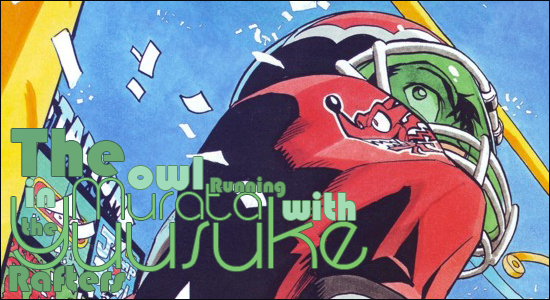
Tyto, here! Welcoming you all to another installation of The Owl in the Rafters. Last time I covered the little known but much loved underdog artist/author, Komi Naoshi, and his lineup of heart warming one-shots, and one very special, but sadly short-lived serial title. I praised Naoshi as an up and coming artist to keep an eye for in the future of JUMP magazine, and this week I’ve got another buzz name to keep your eyes open for. That name is Yuusuke Murata.
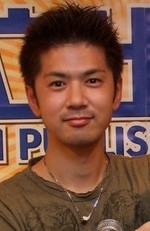
Murata is just one half of the creative team behind the hit manga series, Eyeshield 21. His partner in crime, Riichiro Inagaki, wrote the script for the much loved sports title, while Murata made his big serialized debut as artist. I will say it right now, that despite what feelings you all may have towards the sport of American Football, I strongly encourage -neigh INSIST- that if you are a fan of shounen manga, that you give Eyeshield 21 a try. I will admit that I have never been a fan of American Football, or any major team sports, and yet this manga series had me flipping past everything else in Jump every week during its publication.
Despite my usual M.O. the bulk of this will be about Eyeshield 21, and so just as much will be said about Inagaki’s writing as will be said about Murata’s art for a good portion of this review. To balance thing out a little, before I dive headlong into the real meat of the subject, I’d like to take the time to go over a few notable facts about Murata to highlight his artistic skills:
For starters, as something of a testament to Murata’s latent potential, I think it’s worth pointing out that when he was just 12 years old, Murata’s name was featured in a special thank you section of the credits of the NES game, Megaman 3. And in following years he was also credited in Megaman 4 and Megaman 5 for the designs of Dustman and Crystalman, respectively.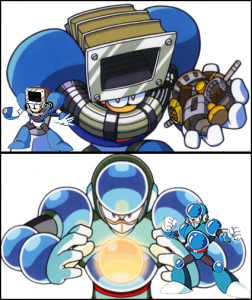 Following his climb upwards we see his big break into manga with, as I mentioned briefly in a previous article, Murata apprenticing with famed artist, Takeshi Obata, the artist of Death Note and Hikaru no Go. Like many of Jump’s popular artists, Murata was a recipient of Shueisha’s HopStep award, given young, new, up and coming artists. His oneshot Partner, won him the 122nd Hop Step competition. Another of his oneshots, Samui Hanashi, won runner up in the 51 Akatsuka award, another of Shueisha’s awards given to young new artists specifically for comedy manga.
Following his climb upwards we see his big break into manga with, as I mentioned briefly in a previous article, Murata apprenticing with famed artist, Takeshi Obata, the artist of Death Note and Hikaru no Go. Like many of Jump’s popular artists, Murata was a recipient of Shueisha’s HopStep award, given young, new, up and coming artists. His oneshot Partner, won him the 122nd Hop Step competition. Another of his oneshots, Samui Hanashi, won runner up in the 51 Akatsuka award, another of Shueisha’s awards given to young new artists specifically for comedy manga.

That all being said, the development he has made to his art style since drawing Eyeshield 21 is nothing short of phenomenal. Murata was recognized for his great improvement and was commissioned to create several posters with the cast of all of Jump’s hit titles for Jump’s 40th Anniversary in 2008. Of the three posters, each featuring anything from two dozen to one hundred different Jump characters, all are beautifully painted in full color. Apart from his own series and the Jump 40th posters, Murata has also had his work highlighted in various tributes to other artists. He was one of nearly a dozen Jump artists who submitted art for a collection of Dragon Ball(Z) color illustrations in the different distinctive art styles of other hit manga artists. 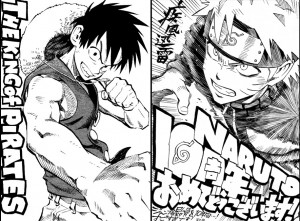 He also submitted sketches for Jump’s One Piece 10th anniversary fan-art collection, and the Naruto 10th anniversary collection. In addition, when JUMP S.Q. II first ran chapter 1 of Stan Lee and Hiroyuki Takei’s collaboration, Karakuri Douji: ULTIMO* there was included in that issue, a gallery of Marvel fan art by various Jump artists, and among them Murata’s illustration of Spiderman proved particularly memorable.
He also submitted sketches for Jump’s One Piece 10th anniversary fan-art collection, and the Naruto 10th anniversary collection. In addition, when JUMP S.Q. II first ran chapter 1 of Stan Lee and Hiroyuki Takei’s collaboration, Karakuri Douji: ULTIMO* there was included in that issue, a gallery of Marvel fan art by various Jump artists, and among them Murata’s illustration of Spiderman proved particularly memorable.
*For those of you who don’t know, ULTIMO is a manga series credited as being illustrated by Hiroyuki Takei, the artist of Shaman King, and written by none other than Marvel Comic’s Stan Lee. This was the first of Stan Lee’s big attempts at making a hit series in Japan; the second attempt was the anime series HEROMAN.

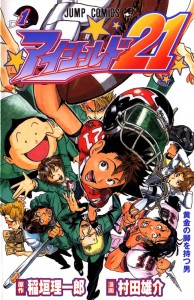
Now, I’m sure some of you are hesitant to pick up manga about American football, but let me just say that Eyeshield 21 does a surprisingly good job of teaching the basic rules of American football, one step at a time, right from the get go; so for those less sports inclined readers, don’t fret about getting lost in terminology or rules you aren’t familiar with! To be honest, I’ve never been a big fan of American football myself, but despite that Eyeshield 21 is still easily one of my favorite Jump titles. While this was Murata’s first serial title, I should point out that Riichiro Inagaki was already a fairly well established manga author with several small works published in Big Comic Spirits magazine. Inagaki was also the winner of the Weekly Shounen Jump’s 7th Story King competition in 2001.
Eyeshield 21 follows the life of highschool freshman, Kobayakawa Sena, a friendless wimp of a kid who only just recently made his way into Deimon High School. (The play on phonetics is, of course, totally intentional) There, his only real friend of sorts is Anezaki Mamori, a girl one year older than him who has been chasing off bullies for Sena since he was in kindergarten. 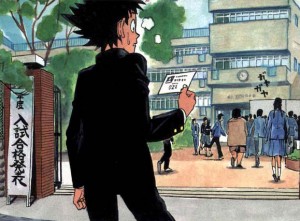 But come this fresh new high school life, Sena is ready to put his life of being constantly bossed around and picked on behind him. Old habits die hard though, and Sena’s lack of confidence and mousey nature peg his as an easy target for the high school bullies. There is a catch though, Sena has spent his life running errands as other people’s gopher and avoiding being beaten up, so after so many years of being pushed around, he’s got a talent for running fast and dodging his way through and around busy crowds.
But come this fresh new high school life, Sena is ready to put his life of being constantly bossed around and picked on behind him. Old habits die hard though, and Sena’s lack of confidence and mousey nature peg his as an easy target for the high school bullies. There is a catch though, Sena has spent his life running errands as other people’s gopher and avoiding being beaten up, so after so many years of being pushed around, he’s got a talent for running fast and dodging his way through and around busy crowds.
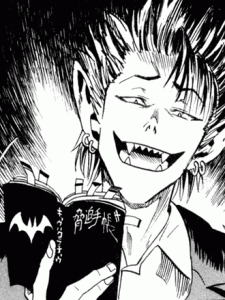
This peculiarly cultivated talent of Sena’s catches the eye of Deimon High School’s own infamous, devilish second year student, Yoichi Hiruma. Hiruma is a seemingly insane tyrant who has most of the school’s student body, and even the faculty, under his thumb thanks to his little black book of humiliating, and reputation ruining, dirty, little secrets. And as it just so happens, Hiruma is also the quarterback and captain of Deimon’s American Football club. Once Hiruma sets his sights on recruiting Sena’s lighting fast legs, he decides that Sena has the potential to be an all-star running back. But of course, Hiruma has no intentions of “asking” Sena to join the team, and even if he were he’s not the type to take “No” for an answer.
Deimon’s American Football club has a reputation all its own, even ignoring the the stigma around its demonic team captain. 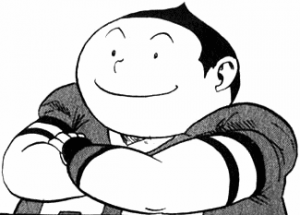 The Deimon Devil Bats are just two men strong, Hiruma playing QB, and Ryokan Kurita the super heavyweight defensive lineman. Now even if you’re not familiar with the rules of Football, I’m sure you realize that two players do not compromise a team. So, to compensate for the lack of actual Football club members, Hiruma uses his influence to blackmail members of other sports clubs to play on game days. But without any practice as a team, the Devil Bats lack the unity and discipline needed to win. As a result the Devil Bats are the Kanto region’s notorious 0 win underdog team.
The Deimon Devil Bats are just two men strong, Hiruma playing QB, and Ryokan Kurita the super heavyweight defensive lineman. Now even if you’re not familiar with the rules of Football, I’m sure you realize that two players do not compromise a team. So, to compensate for the lack of actual Football club members, Hiruma uses his influence to blackmail members of other sports clubs to play on game days. But without any practice as a team, the Devil Bats lack the unity and discipline needed to win. As a result the Devil Bats are the Kanto region’s notorious 0 win underdog team.
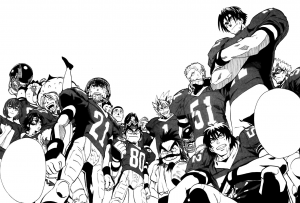
Finding himself suddenly thrust onto the field and inescapably bound by Hiruma’s devious clutches, Sena watches and helps the Deimon team grow and improve, and finds that for the first time in his life he has something he can feel passionately about, the drive to reach for higher goals, and most importantly, friends that he can trust and rely on to share the joys of success and bitter tears of failure with.
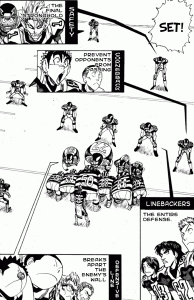
As far as the plot goes, it sticks to a conventional and reliable shonen format, following a fairly predictable repetition of new rivals, conflicts in strategy, training, and the final resolution. The story takes its time early on, laying down the sport rule by rule, play by play, and position by position, until the team is fully fleshed out with a wonderfully diverse cast of characters that I can guarantee will grow on you by the time you reach the heart of the story. Inagaki’s writing takes the sturdy, tried and true plot of your typical sports film, and blazes the trails from game to game with constant suspense and drama tied to the nature of being the underdog, the nobody, and the have-not in a battle of wits, talent, and determination.
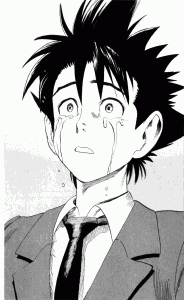
In regards to story and character development, both stand out as surprisingly well written. Typically the problem with any sports series is that any reader’s first impression is that the winning is what’s important, and if you ever stop to really consider things of course it’s obvious that the heroes will have to win, but Inagaki makes a fantastic habit of throwing all kinds of twists at you. As I’ve said before, the characters are all written in a way that’ll warm up to you quickly, but that goes for more than just the Devil Bats team. Almost every opposing team has their own cast of interesting players with their own motives and back stories, and more often than not the victory you were probably expecting from the get go is unexpectedly paved over top of crushed hopes and broken dreams.
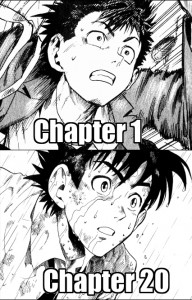
Normally with writing like what Inagaki shows off in Eyeshield 21, I’d be willing to say that it’s the kind of story that would go over well with its audience no matter who was drawing it, but in this one case I honestly believe that no one could have done this story more justice than Murata did. Murata’s art started out very noticeably rough in the early chapters, as most artists’ tend to in their first big serial title, but by the time the series hit chapter 20, his art had already miraculously developed from what was at first nothing more than a passable generic shonen art style, into the start of something truly promising. By the time chapter 80 rolled around Murata’s art style had been cultivated into something truly extraordinary in Jump’s lineup of artists.
But the quality alone isn’t what makes Murata’s art so crucial to the manga’s success. You quickly come to realize as the story go on that with what might be a tad bland in a perfectly normal setting, Murata has dressed to the nines in a stunning thematic wardrobe. Every team has a basic mascot that influences the theme of their design. The Deimon Devil Bats are of course the devilish tricksters, always having to gamble on risky and unexpected strategies to give them the edge over the bigger and more balanced teams. Yet all the other teams have their own unique personalities that shine through in their own unique themes.
Murata has dressed to the nines in a stunning thematic wardrobe. Every team has a basic mascot that influences the theme of their design. The Deimon Devil Bats are of course the devilish tricksters, always having to gamble on risky and unexpected strategies to give them the edge over the bigger and more balanced teams. Yet all the other teams have their own unique personalities that shine through in their own unique themes.
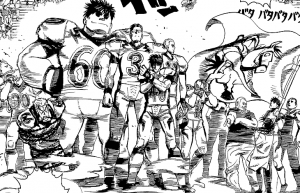
First in the Devil Bats’ lineup of rivals is the super defensive team of the prestigious Oujou Preparatory Academy: the Oujou White Knights. Their mascot is of course the White Knight, a lance armed knight on horseback. Their white uniforms are accented in blue and branded with their signature shield and cross. Their plays and specialties are all named around terms relating to European medieval knights: from their offensive star’s signature Spear Tackle and later improved Trident Tackle, to the Sagittarius formation, to the team’s secret specialty play, The Ballista. They serve as Deimon’s first major obstacle in the Kanto region tournament and provide the story with some of its most loved supporting cast members, like Shin Seijuro, the Bruce Lee inspired fitness fanatic who proves Sena’s biggest rival throughout most of the series; Sakuraba Haruto, the pretty boy male model who has to choose between his job as a model or his future with the team; and Takami Ichiro, the White Knights’ calculating quarterback who makes up for his overall average athletic ability with a cool head, strategic mind, and calm leadership abilities.

While the White Knights provide a kind of literary foil to the Devil Bats by contrasting the Devil Bats’ offensively minded strategies with a heavy defensive team, Deimon’s other big rival team, the Seibu High School’s Wild Wild Gunmen, challenge the Devil Bats at their own game. With their signature play being the Shotgun and their mascot being a six-shooter wielding cactus decked out in full cowboy attire, I’d say the wild west theme is abundantly clear. Their fast-handed quarterback, nick-named “The Kid”, hands out lighting fast passes with his signature Quick Draw, while Seibu’s receiver, Tetsuma Jou, barrels through opposing defense like a steam engine.
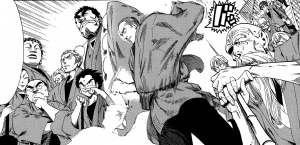
The reigning Kanto champions, the Nagas of Shinryuuji High School, clad in ominously dark uniforms trimmed in red and yellow flames, later appear on the scene as the first real villains. Genius athlete, delinquent punk, and all around detestable jerk, Kongo Agon is a man “blessed by the gods” with an ability dubbed, God Speed Impulse. Unlike all of the previous rivals to appear in Deimon’s path, Agon’s ability doesn’t come from hard work or determination. No. Agon was simply born with especially fast reflexes and a natural talent for learning through muscle memory, which keeps him in above average physical shape with practically no need to work out. Tack on a cocky personality and ruthlessly violent temper and you have the kind of villain that can only be described as perfect. From the moment Agon shows up, you want to see him put in his place, and it keeps you rooting for Sena and the Devil Bats all the harder, and cheering all the more when they finally come out on top.
Other notable teams include; the Yuuhi Guts, the Amino Cyborgs, Dokubari Scorpions, Hashiratani Deer, Kyoushin Poseidons, Zokugaku Chameleons, Sengoku Samurai, Noroi Occults, Jounandai Giants, Sangaku Punks, Bando Spiders, and Edomae Fishers.
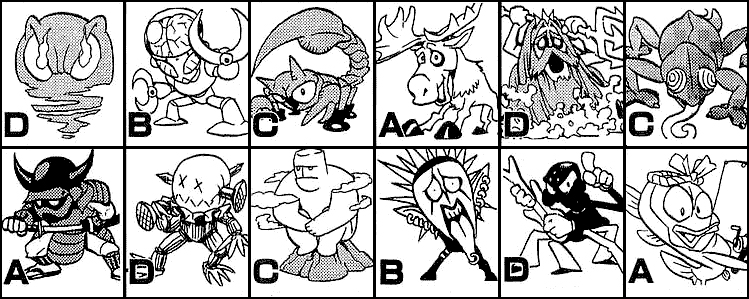
I could go on about every team in the series, but I’ll spare you the grief and just touch on one more team before moving on: The laughably named and lovably goofy American team, flown into Japan from Houstan, Texas, the NASA Aliens. 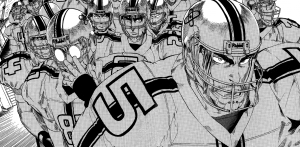 Sporting a line up of specialties like the Shuttle Pass and the Zero G Run, the Aliens are led by their racist coach, Leonard Apollo. The game against the Aliens takes the time to addresses the issue of racism, which is a very unusual topic for Japanese audiences, particularly in younger readership.
Sporting a line up of specialties like the Shuttle Pass and the Zero G Run, the Aliens are led by their racist coach, Leonard Apollo. The game against the Aliens takes the time to addresses the issue of racism, which is a very unusual topic for Japanese audiences, particularly in younger readership.

The gist of the Aliens story is that the team is all white boys with the exception of their ball-boy, Patrick Spencer, nicknamed Panther. (If you don’t get it, the name Panther is a play on the Japanese phonetics for PA-to-ri-ku su-pe-N-SA. Take out all bet the first and last syllables and his name shortens to PANSA, which is pronounced that same as panther.) Coach Apollo’s blatant racism manages to drive off all of the black kids on the team, except Panther, who stays around as the ball-boy despite the coach’s attitude. By the end of the Aliens’ game, Coach Apollo admits to being blinded by his racism, and Panther is finally accepted as a real member of the team. It turns into a surprisingly sentimental moment and just one of many uplifting and almost awe inspiring moments in Eyeshield 21.
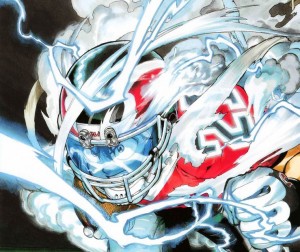
All these over the top and quirky little gimmicks build a surprisingly fun atmosphere that I really think is the key to what keeps Eyeshield 21 feelings so fresh from chapter to chapter. It’s the little bit of stylistic flare in the typically shonen-style special moves and secret techniques that allows Murata to really show off his ability to create truly breathtaking action scenes that keep the games from going by in one big unimpressive blur like the action scenes in most shonen series.
In the end, what Eyeshield 21 boils down to isn’t a sports series so much as it is a story about making friends and chasing dreams with undying determination, even in the face of overwhelming odds.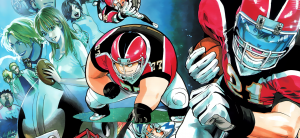 It’s a classic under dog story that happens to be about a high school Football team in Japan, but the characters, their stories, and the emotions that you’ll inevitably find wrenched out into the open by this series all carry truly universal appeal.
It’s a classic under dog story that happens to be about a high school Football team in Japan, but the characters, their stories, and the emotions that you’ll inevitably find wrenched out into the open by this series all carry truly universal appeal.
I’m sure by now you’ve had about enough of my rambling about Eyeshield, and I promise I’m done, but as a kind of disclaimer/foot note I do want to caution you all against watching the Eyeshield 21 anime series. While it managed to survive as a long running series, the anime proved very poorly done. The art design, animation, and even voice acting of the Eyeshield 21 anime are all either off the mark or lacking, if not outright bad. The voice acting is lack luster in many cases, losing a good deal of the feeling that makes the manga so memorable. The animation is clunky and awkward at best in most moments, lacking all of Murata’s artistic flare and timing. Even the character designs are compromised and Murata’s art style nearly lost in the transition to animation.
While it managed to survive as a long running series, the anime proved very poorly done. The art design, animation, and even voice acting of the Eyeshield 21 anime are all either off the mark or lacking, if not outright bad. The voice acting is lack luster in many cases, losing a good deal of the feeling that makes the manga so memorable. The animation is clunky and awkward at best in most moments, lacking all of Murata’s artistic flare and timing. Even the character designs are compromised and Murata’s art style nearly lost in the transition to animation.
Now, I could keep going on about Eyeshield 21 for an article all its own, but rather than break the series down plot point by plot point and ruin the suspense inherent to reading through the series yourself, I’ll move on to Murata’s later works. You might remember that I said Murata has only ever had one hit title, that being of course Eyeshield 21. His early works were all oneshots, most of which garnered little attention outside of Jump’s editorial staff and which are subsequently unavailable in any digital format. What that leaves us with are the several oneshots Murata published in Jump during and after the start of Eyeshield 21, a running comedy strip, and one other ongoing series.
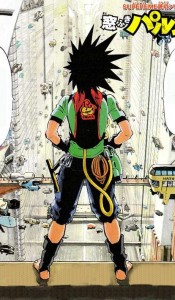 This first of these, and by far the strangest, is Madofuki Park. This oneshot that was published in the middle of Eyeshield’s run in 2008 follows the story of a boy named Park as he goes about his life washing windows in the futuristic “sky city” of Tokyo. A quirky premise to be sure, but the story itself is truly mediocre. Murata tries to play into some conventional tropes of the shonen genre: the hero struggles to make ends meet for the sake of his ill grandfather, and his almost contradictory light-hearted and mischievous nature might feel all too familiar from other popular shonen heroes. Still, the over all product is by no means “bad” it just fails to impress on most levels.
This first of these, and by far the strangest, is Madofuki Park. This oneshot that was published in the middle of Eyeshield’s run in 2008 follows the story of a boy named Park as he goes about his life washing windows in the futuristic “sky city” of Tokyo. A quirky premise to be sure, but the story itself is truly mediocre. Murata tries to play into some conventional tropes of the shonen genre: the hero struggles to make ends meet for the sake of his ill grandfather, and his almost contradictory light-hearted and mischievous nature might feel all too familiar from other popular shonen heroes. Still, the over all product is by no means “bad” it just fails to impress on most levels.
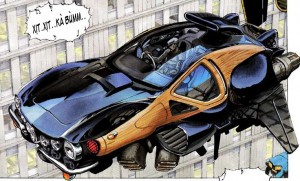
“MOST levels” I say because while the story, characters and premise are all perfectly average, Murata’s artwork continues to be truly stunning. His grasp of color, perspective, and depth are all mind blowing, as his opening 5 color pages are quick to remind you. His bright and lively cityscape are breathtakingly painted, and his remarkable ability to work with reference material is pushed to its limits as he crafts a beautifully colored futuristic car from a composite of reference and his own imagination.
The bottom line for Madofuki Park is that Eyeshield 21 was withint sight of its end at the time and Murata needed to assert himself to the public to secure his position as a notable artist. The impact of his story was certainly lacking, but in terms of leaving a strong impression with his art, I’d say he accomplished his goals and then some.
Also published in 2008, as the first chapter of an ongoing comedy by Murata, Hetappi Manga Kenkyuujo R. The story stars Murata himself, and disgruntled shonen Jump editor, Saitou. Sick of his overworked and underpaid job as an editor, Saitou wants to leave behind his days as an editor and take the spotlight as a manga artist. His first big hurdle? He can’t draw. So, he tracks down none other than Yuusuke Murata and forces poor Murata to teach him how to draw. The series runs like a “How To” book, with Murata going over everything from tools to tips and techniques in his attempt to teach Saitou how to draw manga. There are also several segments that have featured other manga artists as guest lecturers on specific subjects, like Kawashita Mizuki, the artist of Ichigo 100%, Matsui Yuusei of Nougami Neuro, and Shimabukuro Mitsutoshi of the manga Toriko.

Next up is, BLUST!. Published right after the end of Eyehsield, the 51 page oneshot follows the story of a young man named Hokazono Kai, code named Blust, a mercenary turned military guineapig during a failed mission. He escaped however and escaped mostly intact, save the arms he lost to his captors’ human experiments, in the cybernetic prosthetic arms he obtained as a result he holds the experimental technology meant for a nuclear resistant soldier project. For whatever reasons this power also happens to be powered by curry, which leads to an almost Popeye the Sailor-esque moment by the end of the oneshot.
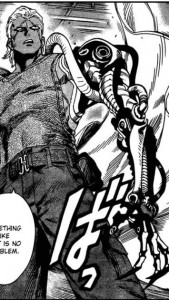
So, in an almost laughably classic shonen style, Murata tries to pitch us a young, super powered hero with a big appetite, but offset by an oddly modern setting. As Kai sets off on a new mission in the war-torn country of Padagodia, Murata takes the chance to really show off his set work, going out of his way to illustrate detailed vehicles and genuinely impressive ocean scenery. In any case, the story presents a simple goal; to find a sunken treasure of sorts and retrieve it. Almost immediately upon embarking on this mission however a fight breaks out with the finished product of the same experiment that gave Kai his curry powered blaster arms. What ensues is a genuinely epic fight scene that I can’t help but feel mirrors some indistinct memories of the original Dragon Ball.

The fight is really the high point of the oneshot and it ends in a typically goofy sort of “to be continued…” that really hammers home the perfect shonen feel of the whole story. But I will admit that I have definite qualms with Blust!. For one, the format of the story is easy enough to get a hold of: Kai is a mercenary he takes on random missions. Anything could happen. The fictional twist on what otherwise appears to be a modern day setting is awkward however, and while Murata’s ability to beautifully put together these exotic locations is always present, the concept itself seems uninspired and bland. His panel layout displays a real knack for spacial coordination, and his sense of motion from panel to panel, particularly in his fight scenes really is unique. His use of perspective is far more diverse than most other common place shonen artists in Jump, but from a story telling perspective, it just doesn’t seem to have the sort of hook I think Murata was going for. Rather than tapping into some whimsical sense of adventure with the exotic and foreign, it just feels like staring at a vacation brochure. The mercenary premise seems good on paper, but when you really look at a curry powered cyborg bodyguard, it’s about as appropriate as Naruto claiming to be about ninjas.
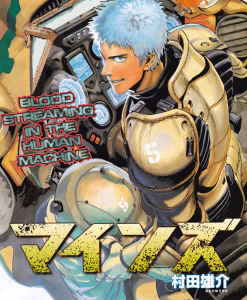
Now, the most recent of Murata’s one-shots, Minds. A 2010 publication that likely lead to Murata’s most recent serial title, but I’ll get to that later. Minds is a fun action-packed military story of a sergeant nicknamed the “Iron Heart.” Among his subordinates he is considered a fearless daredevil who constantly takes on high risk reconnaissance missions into enemy territory by himself. His goal in such reckless death defying behavior? To get promoted from the frontline to a position of power where he won’t have to fight anymore. Or at least that’s what he tells everyone around him. His real goal is to reform the twisted military system that has allowed for him and his comrades to be treated like disposable pawns. The story tries to come across as more series, but given the amount of emphasis on the characters, yet the fairly shallow and straightforward motives, it really doesn’t seem to hit its mark. Once again however, Murata proves himself a master of both vehicle and equipment work, and truly dynamic action scenes. The pacing and panel work of the action scenes are as impeccable as ever and the highspeed chase scenes make me wonder why Murata hasn’t done a flat out racer series with either cars or motorcycles yet.
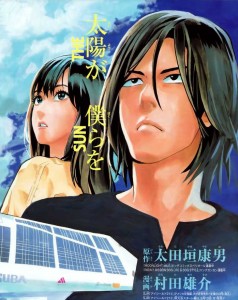
Taking a step in what might be considered the right direction, Murata continues to play up his strong points with his current running monthly series in Jump SQ, Donten Prism Solar Car. Certainly not his best name, but I think by now it’s safe to say that Murata tends to have some kind of problem with anything but non-literal titles. The story focuses on Kaneda Shouta, a young man who lost his father to a car accident when he was young and has been traumatized by the experience ever since. He has a job at an ironworks factory run by his uncle and has been saving money from his work with his uncle as well as part time jobs around the city in the hopes that he can one day afford to go to college. His quiet, hardworking life of labor is interrupted however, when a group of engineering students rents out the storage space beneath his dorm to use for their project to restore an outdated experimental solar powered car. Unlike Murata’s previous attempts, he seems to have found his place with SQ writing a drama instead of a more traditionally action oriented shonen. The series is thus far only about 5 chapters long, running on a monthly basis with Jump SQ, with around 50 pages to a chapter.

Apart from what I’ve already said about Murata’s knack for vehicles and set work, Murata also has a very underplayed habit of designing genuinely attractive but modestly presented heroines. In all his series he has some kind of female support character who displays an outgoing and independent personality. For the purposes of the plot, these girls rarely extend beyond moral support, but that is sort of a given when writing for a shonen manga. What I still find commendable is his apparent refusal to give in to the popular trend of using overt sexuality when designing his female characters. Instead he gives them a great deal more respect than other artists. As if this weren’t out of place enough in a shonen magazine, he still manages to give them all a distinct air of beauty despite their modest proportions and wardrobe. Again, they are all genuinely attractive, and that Murata can accomplish that without resorting to cheap, visual sex appeal is truly impressive.
Congradulations! You made it to the end of the article! Now that I’ve tried me best to give you a good look at most of Murata’s recent work , I hope you’ll feel compelled to dig around and find something of his to read a bit of a see how you like it. While Eyeshield 21 is the only title of his to hit American shelves, thus far, I do hope you’ll keep an eye out for his name in the future as I’m sure he’ll continue to produce interesting work, and beautiful art if nothing else, in the years to come. I hope you enjoyed reading, and I hope you’ll come back for more next time!






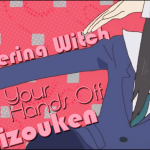










[…] This post was mentioned on Twitter by Solar, 91.8 The Fan. 91.8 The Fan said: The Owl in the Rafters – Running with Yuusuke Murata @ http://tinyurl.com/47obhq7 #anime #manga […]
i will never stop reading this manga. if u ask me how times ive read Eyeshield 21 ill say 7. and im not kidding. i reread every single chapter and volume.
I know the feeling. This is one of those series that just has an unbelievable amount of rereading value. More than that, the tear-jerkers are just as strong the 2nd and 3rd times through as the first. There really aren’t many series that get as emotionally provoking as this as often as it does.
[…] title Double Arts that ran in the weekly Shounen Jump for just 6 months, and the second being Yuusuke Murata, the artist of Eyeshield 21 a sadly overlooked sports title with more general appeal than the subject of American Football […]
[…] have served as inspiration for a number of successful manga authors, not the least of which include Nobuhiro Watsuki (author/artist of Rurouni Kenshin, Busou Renkin, and Embalming), Hideyuki Kurata (original author of Read or Die, EL-HAZARD, and Battle Athletess as well as script […]